I never would have done this if I didn’t work at a gym. I was just starting out as a trainer and was in touch with a small group of mountaineers. They invited me, I accepted. This is my story.
Pico De Orizaba
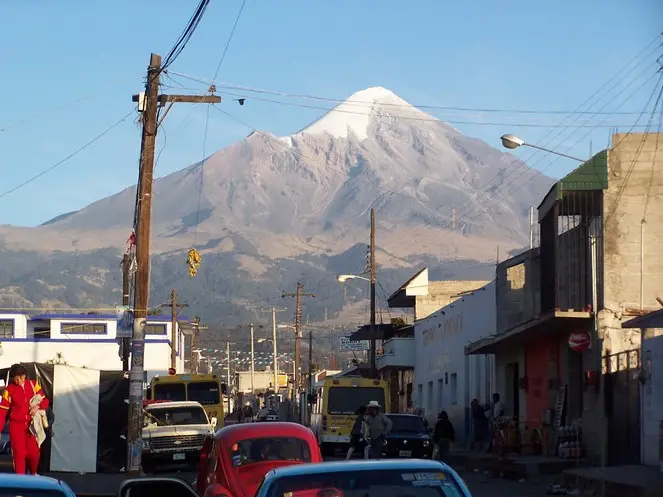
Pico de Orizaba is somewhere between 18,400 feet and 18,700 feet above sea level, depending on what source you use.
It is a volcano. It is not active. It is very, very steep.
Base camp is at 14,000 feet. The city of Tlachichuca is at about 8,500 feet above sea level.
The Team
I was the young buck, 19 years old, in a group of 30’s dudes. The odds were kind of with me, but kind of not. I wasn’t super strong. I had good hiking legs, but I was obsessed with rock climbing (bouldering to be exact) and I didn’t have years of endurance training behind me or anything.
The other guys were a mix, two were ex-bodybuilders, one an ex-firefighter and the other a lawyer with the will of a madman.
We spent 3 months training together.
Training for a High-Altitude, Glaciated Peak
I was honestly into partying a bit much at that time. Our first workout was to run for 20 minutes straight. That really hurt. It hurt my lungs, my legs, my stomach, my pride, everything hurt.
I was told that I had to be able to run 75 minutes straight on the treadmill or I wasn’t going. The thing that is more standard gear for the mountain than having a body, is having a body that can run 75 minutes on a treadmill. If you can’t do that, you might as well not try. In fact, you’re better off not trying because you put everyone at risk.
If one guy slides down the ice, the others get pulled with them. That scared me. Not just because I really didn’t want to be that guy, but I also needed to hold the weight of these other guys if they fell. So, I trained really, really hard.
We incrementally worked our way up in time and distance on running. We also did some circuit training to keep us somewhat strong and we were vicious when it came to core training.
We also did a hike every other weekend with 50 or 60 pounds in our packs. We did this in the same gear we would be using on the mountain so that we could break it in – especially our boots.
We had to be prepared. Training day was nine hours of vertical hiking in a low oxygen environment with about 40 pounds of gear. The ground was often loose rock, and most of the time it was ice. Then it was another five hours to get back down to base camp.
The pace was: we hike for 75 minutes, stop and put on your parkas to keep from losing heat, eat and drink, hike for 75 minutes, repeat.
Affiliate Disclosure: We may earn a commission if you click a link on our site and make a purchase. For more info, see our disclaimer.
Mountaineering Gear List
Here is a list of the gear needed for this trip:
Moisture Wicking Boxers
Moisture Wicking Base Layer
Fleece Pants
Fleece Jacket
Gore-Tex Pants
Gore-Tex Jacket
Beanie
Balaclava
Crampons
Ice Ax
Gaiters
Wool Socks
Glacier Glasses
Climbing Harness
Black Diamond Headlamp
Down Parka
Nalgene Water Bottles
Compression Sacks
Twenty Degree Sleeping Bag
Inner Gloves (Liners)
Outer Gloves
My Last Night in Civilization
There was a cool little climber’s hacienda compound where we stayed called Servimont. Everyone was friendly there and it had great home-cooked food. We had a big row of bunk beds for sleeping and they had a few common rooms.
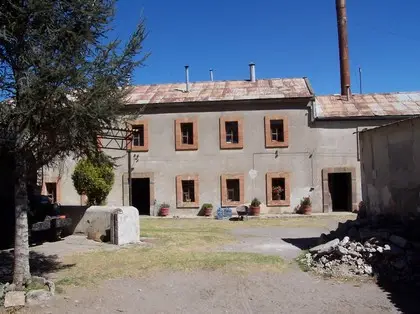

The night before I left, I watched the movie Into the Void. It is about a mountaineering expedition gone wrong. Scared the hell outta me. Maybe it was a good thing, maybe it was bad. I was in a foreign country about to do something very life-threatening, so… yeah.
The Guides
We had two rockstar guides – Garrett Madison and Michael Horst. It was a privilege to work with these two very competent individuals. They were beyond professional throughout the trip.
Dropped Off on Pico de Orizaba at 12,000 Feet Above Sea Level
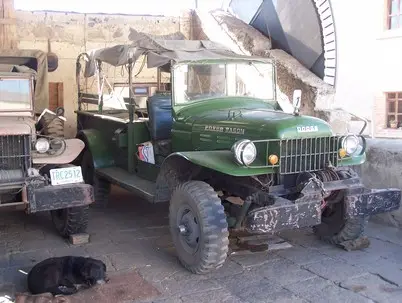
There were three 4X4 Dodge Power Wagons that took us and our gear up to 12,000 feet where we camped the first night. We got dropped off and turned into kids and went into full camping mode. Shit talking was par for the course. Seven big dudes fighting over food. We didn’t know if we should load up on food now or save it. Everyone was nervous but keeping their cool.
I started to feel the altitude at this point. Moving around at 12,000 feet was more taxing than moving around at my usual 4,000 where I lived. It wasn’t terrible, but it was noticeable. We took a small nature walk to get the blood flowing. You don’t want to go to high altitudes and not move around. Drink water, keep moving. Breathe…
Side note: One of the Dodges had a fuel pump that went out. We watched as this 4X4 (with our gear) came up the hill backwards toward us. The guys figured out that if you drive it backwards, that fuel can get to the engine by way of gravity. Thank you, Servimont!
The Hike Up To Base Camp on Pico de Orizaba
Base camp was at 14,000 feet. The next morning, we packed up camp and hiked up the next day. That was a good acclimatization hike to get us used to the altitude. Our bodies had never spent this much time in an environment with this low oxygen. This is what altitude training is all about.
Just sitting down and doing nothing my heart was going as if I was at a very brisk walk. It was odd. When I went to lie down for bed, I noticed that it was just pounding away. Walking around at that altitude was a chore. Bending over made my head pound. Relieving myself took much more energy than it did back home. I’ll spare you the details.
We spent a couple of days at base camp. We put on our crampons and grabbed the ice axes and practiced self-arresting in case we started to slide down the ice while we were all roped together. We rope together so that we can save someone in case of a misstep or if someone starts to dive down a crevasse. That was a dirty, but fun day. The environment was much harsher than my usual hangout. We kept ourselves somewhat reserved. We were still scared, but loosening up and getting ready for the drive to the top. It didn’t help that the weather wasn’t looking great. We didn’t want all this training and preparation to be for nothing.
On day two at base camp, we hiked from 14,000 to 15,000. That was actually fun. But, I was scared out of my mind at how hard my body was working to circulate oxygen. How could I possibly go all the way to the top? There is even less oxygen up there and I’ll be on pure ice? I kept my concerns to myself, but I was terrified.
Summit Morning
We went to bed early. Like – freaking 7PM early. Basically, we put our bodies in our tents and were horizontally talking shit to each other. I was in the middle of two dudes. We all smelled. I quietly thanked my dad for all of his loud snoring. Without those years of training, I wouldn’t have gotten any sleep next the two chainsaws I was stuck with.
We got up at 2AM, geared up and headed out. I had been thinking of this exact moment for over 3 months. We were nervous and excited.
It kind of felt like going to war. Every piece of gear in its place. Plans running through my head on what we do if this happens, what happens if someone slips into a crevasse…
But it was a quiet and rather socially chill event. We had everything packed the night before so there wasn’t going to be any problem.
The Push to the Top of a Volcano
The day was somewhat monotonous. We stared at each other’s feet and hiked and hiked up into atmosphere that got thinner and thinner.
At one point, before the sun came up, we had to climb vertically in full gear. This saved about an hour and we were fit enough to do it. The guides rigged up some safety lines and made sure we got up nice and safe.
We hit the base of the glacier just after sunrise.
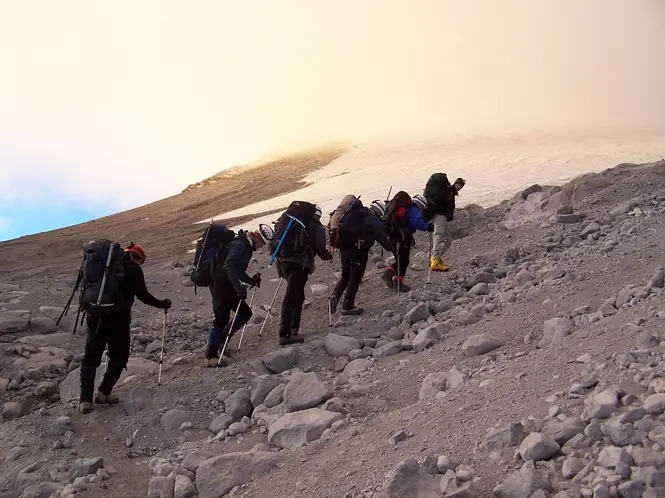
At this point we had a member of ours that had some problems. He didn’t do most of his training with us and was feeling the effects of altitude. He fell at one point and just kept rolling without stopping himself. We pushed a little further and then at the base of the glacier we rested. The guide checked him out and asked him questions. He didn’t know what mountain he was on or what country he was in. At this point, one guide took him down.
We then got our crampons on, clipped into a rope and donned our axes. I stepped on a glacier for the first time in my life.
Okay, this was somewhat exhilarating. The sun was rising, and I could see far and wide. We were walking up into the clouds – literally. I had an ice axe in my hand, and we were going to the top of a volcano. I was about to see a crevasse for the first time in my life! I had these really cool glacier sunglasses on, along with a balaclava. I was walking up into a cold, oxygen-deprived hell.
It was awesome.
We tied knots, roped up and picked a pace that worked. We maneuvered the sun-cupped ice. I started taking 4 breaths per step. We crossed a few crevasses, started taking six breaths per step. We crossed another and another…
The wind was also interesting and worth noting here. It wouldn’t just gust from one direction and stop. It would gust from my right, then change directions before it stopped. So I would lean right and slowly lean towards my front, then my left before returning to where I was. This was while I was forcing six breaths in and out of my lungs between every step.
If I got four, I was dying. If I got eight, I felt like Superman. The pitch was something like 40 degrees.
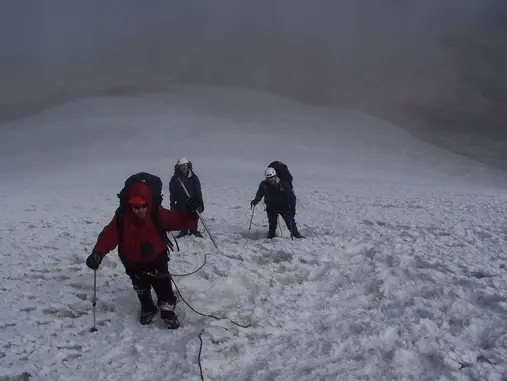
The way the mountain is shaped, it always looks like you can see the top. The clouds were heavy and they would blow away for a few seconds, I’d be like “Oh, just an hour or so.” Then an hour would go by and we would still be an hour away. Meanwhile, my body was fighting like mad to just keep going. My heart was racing and most of the time I was just standing and breathing.
At that temperature, my fingers and toes were getting numb and freezing up. I had to, while hiking, also think about wiggling my fingers and toes that were numb. My water bottle froze in my pack.
Eventually we got up. Looking into the mouth of a volcano is one hell of a sight. The wind was howling so footage was terrible, and I was so out of it that my finger was covering most of the photos. We had grandiose plans of taking some fun pictures of the top. Those never materialized due to the high winds.
Looking Down Pico de Orizaba
This is when I realized that life sucks.
I’m sitting there, drinking ice/water and shoving some frozen Cliff bar into my mouth – and I’m looking down into the clouds. I savor the fact that this is the worst environment I have ever been in. And that help has never been so far away.
I was looking down into clouds. They were covering ice and crevasses that I would now have to cross again. There wasn’t a quick way or shortcut out of this place. Due to the thin atmosphere, just sitting there, my heart was racing as if I were running down the street. I wasn’t scared, just exhausted.
I was looking at the biggest quadriceps workout of my life. I had never walked slowly downhill for that many hours with this much weight on my back after already having nine hours of continuous exercise in a low-oxygen environment. But my options were to stay and freeze or take the hard road back to wherever it was I came from.
So we went down the mountain. It wasn’t as taxing on the cardiovascular system as it was the quads. We made faster work of it, only hindered by some crampon malfunctions along the way.
Once we got off the ice and hit the dirt, I felt like I was finally out of harm’s way. I dug so far inside to get up that glacier. My head was foggy. My stomach was empty, and I had no fat on my body to spare. The stupid Cliff bars didn’t do anything.
I sat and ate whatever I snack had. I didn’t even taste it. I just moved my jaw until I could get it down. Most of my face was so cold I couldn’t feel it. I washed my snack down with the last of my water.
Some hours later, and moving on legs that were literally shaking, we saw base camp.
We were welcomed with cheers. It was quite an experience. Similar to that of finishing a race. You know how at the end of a 5k, 10k or marathon race you have everyone screaming and celebrating? It was like that, but for a much longer workout and these people were really scruffy and no one had showered in about a week. I wasn’t feeling as excited as they were, but I do have to say that it was cool. We did it. My body completely hated me for it, but we did it.
Back to Civilization
I can’t describe how nice that shower was or how deep I slept that night. I woke up to the classic sound of “cock-a-doodle-doo” roosters in the heart of Mexico. The fight was over. The months of worrying about whether I would make it or not were over.
I think the physical part was the easy part. I was pretty hard on myself to pull this off. Mentally freaking out over what pocket to put what in and every other little detail was over now.
That weight was off and I felt amazing. It was really cool being able to walk across the room and not breathe 10 times. It took about half a day to get used to it.
My mom had threatened every member of my crew individually. Something along the lines of “Don’t bother coming back if he doesn’t come back.” So I got several reminders to call my mom and tell her I was back safe. I doubt she slept much while I was away.
The Impact and Takeaway
I came back to my regular life and was almost confused as to what to do. When I had to walk such a fine line between survival and death, the usual stuff just didn’t catch my attention.
I looked at the video games I used to play, and the TV.
I ended up selling my surround-sound stereo, PlayStation, games and all sorts of other distractions soon after. I spent the money on skydiving.
Conclusion
Opportunities come up. Don’t say no. Train hard.
When someone says, “You’re coming with us to the mountain.” Just say “Sure, why not?”

